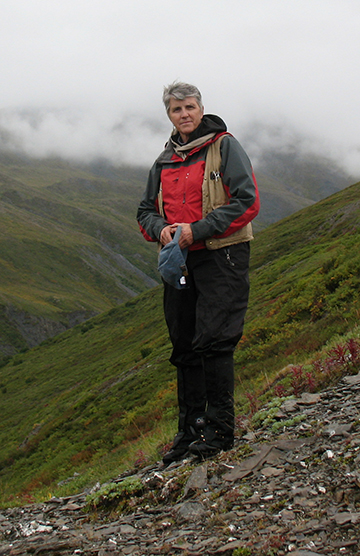CITATION
Laurel Woodruff
2014 Goldich Medal Recipient

It is my pleasure and honor to present the 2014 Goldich Medal to Laurel G. Woodruff. Laurel has been one of the most active and involved members of the Institute for more than 20 years. During that time she has chaired or co-chaired three annual meetings (47th, 49th, 53rd) and served corresponding terms on the board of directors. She was chair of the board of directors in 1995-1996, 2002-2003, and 2006-2007. She has served twice on the student paper award committee, and most recently, from 2010-2013, was a member of the Goldich Award committee, and chaired the committee in 2012-2013. In addition, she has been co-leader of three Institute fieldtrips and has made numerous technical presentations at Institute meetings. In case no one has yet noted, this is the first Goldich citation in which the pronoun “she” has been used.
Most of Laurel’s career, spanning more than thirty years, has been with the USGS mineral resources research program, with more than 25 of those years in the Lake Superior region. Prior to that Laurel received her formal education at University of Michigan (BS in Geology 1973), Michigan Technological University (MS in Geology 1977), and the University of Chicago (PhD in geology 1989). After completing her MS degree and beginning a PhD at Chicago, Laurel was hired to run the light stable isotope laboratory at the University of Wisconsin-Madison and she participated in a broad variety of stable isotope research. The highlight of this part of her career was research on modern seafloor hydrothermal deposits, which culminated in publication of her Journal of Geophysical Research paper on the stable isotope geochemistry of seafloor hydrothermal vent systems.
Laurel joined the USGS in 1983. Her initial assignment was establishing the light stable isotope laboratory in the Branch of Eastern Minerals Resources. When the laboratory became operational, she was responsible for light stable isotope analyses (S, O, and C) of rocks, ores, and mineral samples from a number of locations throughout the world in support of research on seafloor sulfide formation, and precious metal mineralization. In 1986-87 Laurel returned to the University of Chicago to complete her PhD and conducted her dissertation research on diabases of the eastern U.S. Triassic basins as part of a large USGS project on the mineral potential of those basins. Laurel’s scientific contributions to the geology of the Lake Superior region began in the late 1980’s when she became a member of a USGS project team studying the geology and mineral potential of the Midcontinent Rift in Michigan and Wisconsin. Laurel’s contributions included: 1) field work to collect bedrock and mineral deposit samples, 2) preparation of geologic maps and reports, 3) stable isotope analyses to constrain metal sources and characterize regional alteration patterns, and 4) geochemical and 2-D thermal modeling to better understand the origin and distribution of copper mineralization in the rift.
In the past decade, Laurel has become increasingly involved in environmental research and has been a leader in fostering the incorporation of geology and geochemistry into multidisciplinary studies of the behavior of elements of concern such as arsenic and mercury. Her studies of the effect of forest fires on the mercury content of soils in the Lake Superior region and the cycling of mercury in aquatic ecosystems, conducted in cooperation with colleagues in soil science, hydrogeochemistry, and aquatic biology have provided fundamental new understanding of the mercury cycle. Laurel also has been a key figure in establishing procedures for and conducting geochemical baseline studies from local to national scale. The recently completed soil geochemical survey of the conterminous U.S. has produced a new database and a national geochemical atlas based on 15,000 samples from about 5,000 sites across the country. Laurel was a key member of that project from the earliest planning phase, through pilot studies, and the full survey, to the current activities of producing interpretive research papers. Laurel also continues her research on the Precambrian geology and resources of the Lake Superior region and is the coordinator of a new USGS multidisciplinary project on metallogeny and mineral potential of the St. Croix horst in Wisconsin and Minnesota.
On a personal note, Laurel has been a great friend and colleague for more than 25 years as we have wended our way through a kaleidoscope of research from hard rocks, through glacial deposits, and soils, to lake-bottom muck; wanderings across Alaska, the “death marches” on Isle Royale, and hard days of canoeing and portaging through the Boundary Waters and Voyageurs Park. Many of the most vivid and pleasant (at least in hindsight) memories of my career are from those days. Our research has commonly been guided by Laurel’s often expressed philosophy of “Let’s do something even if it’s wrong!” She’s shown over and over through her proclivity for action and her eagerness to plunge into new work, that it is so much easier to make mid-course corrections of something in progress than it is to overcome the inertia of over planning, indecision, and inaction; an attribute that has been unfailingly valuable in so much of what she has done during her career. So, in recognition of her decades of accomplishments and of her dedication to the geology of the Lake Superior region and to the Institute on Lake Superior Geology it is my pleasure to present the 2014 Goldich Medal to Laurel.
Submitted by Bill Cannon, Geologist Emeritus, U.S. Geological Survey